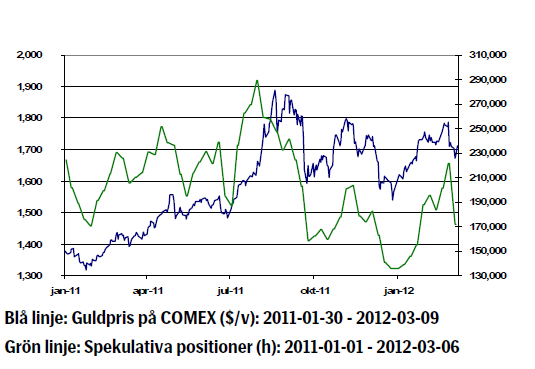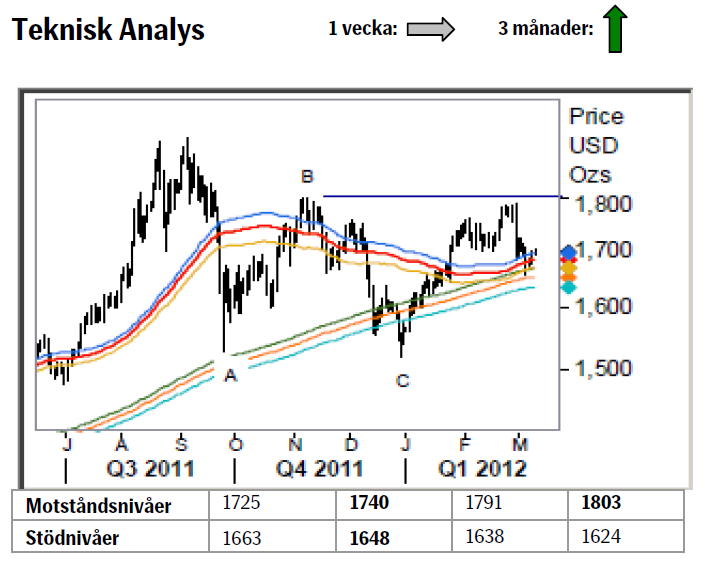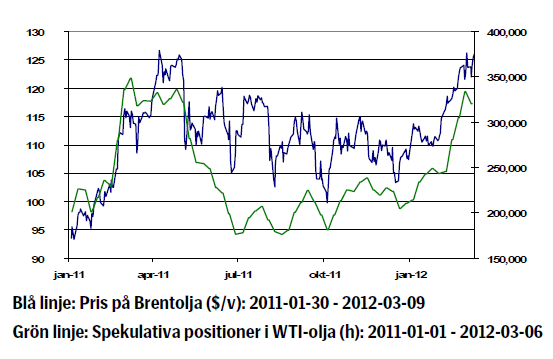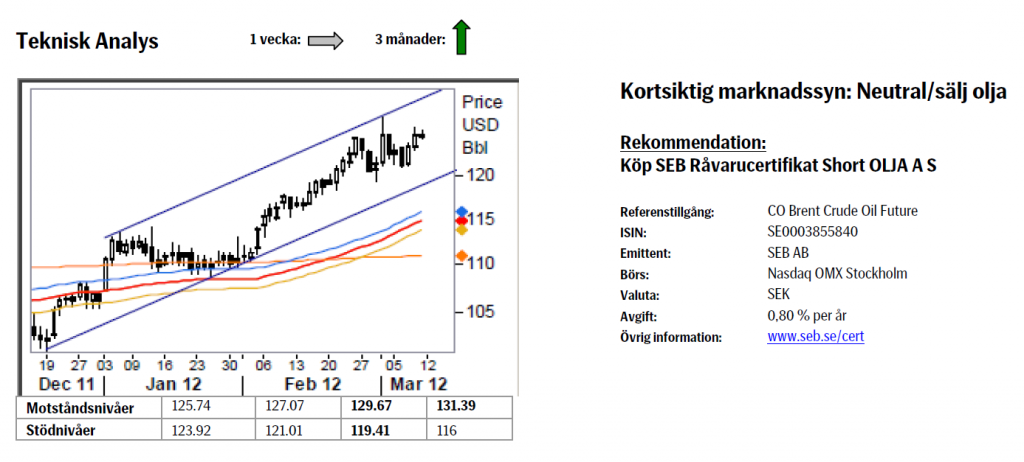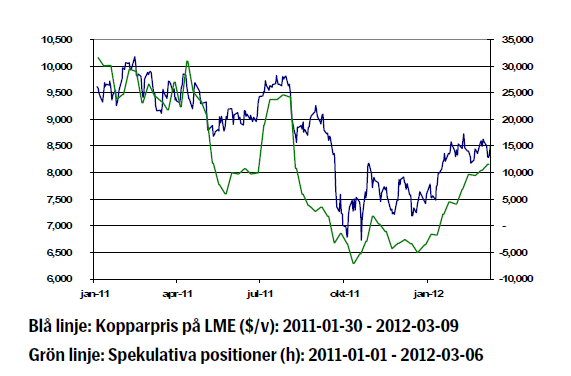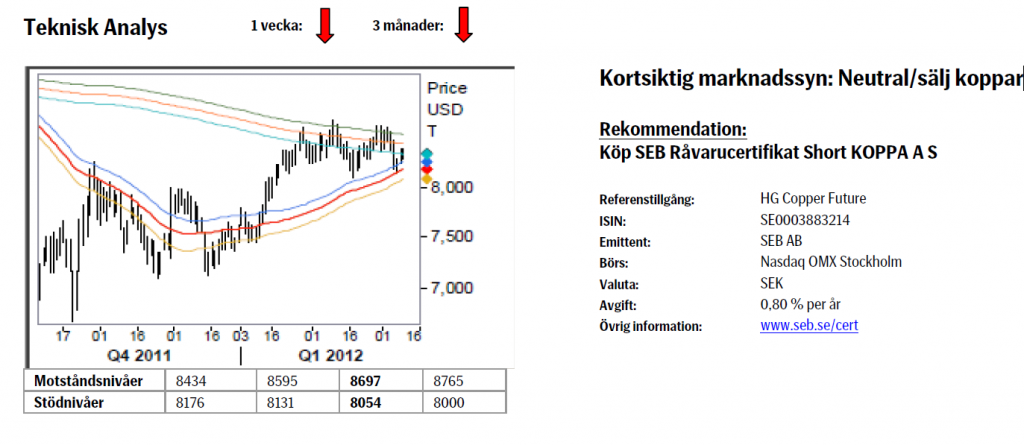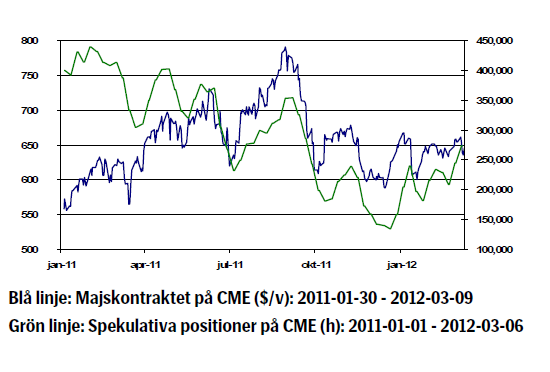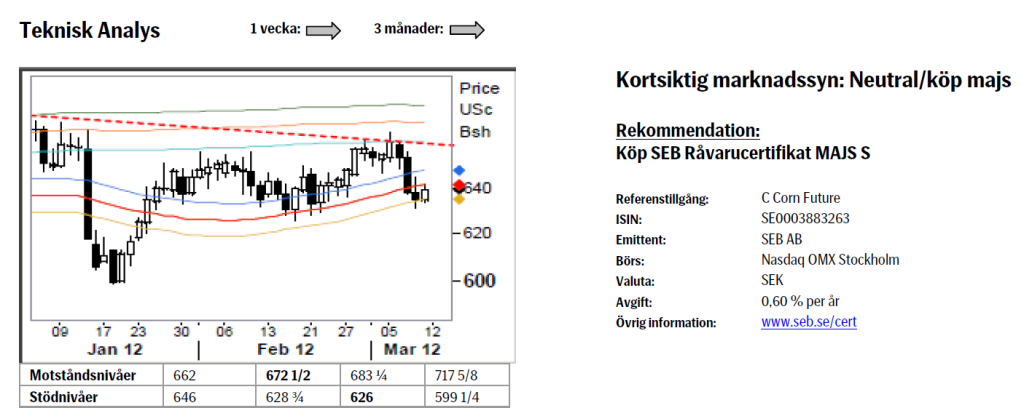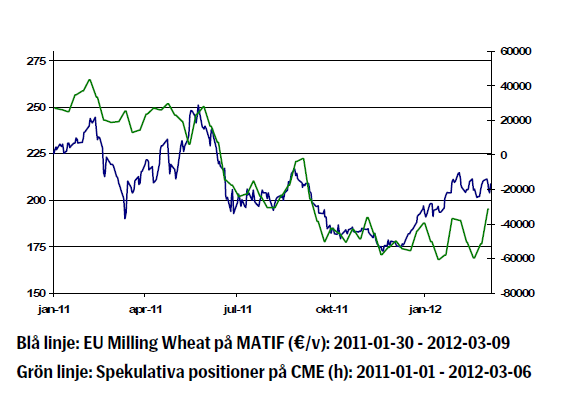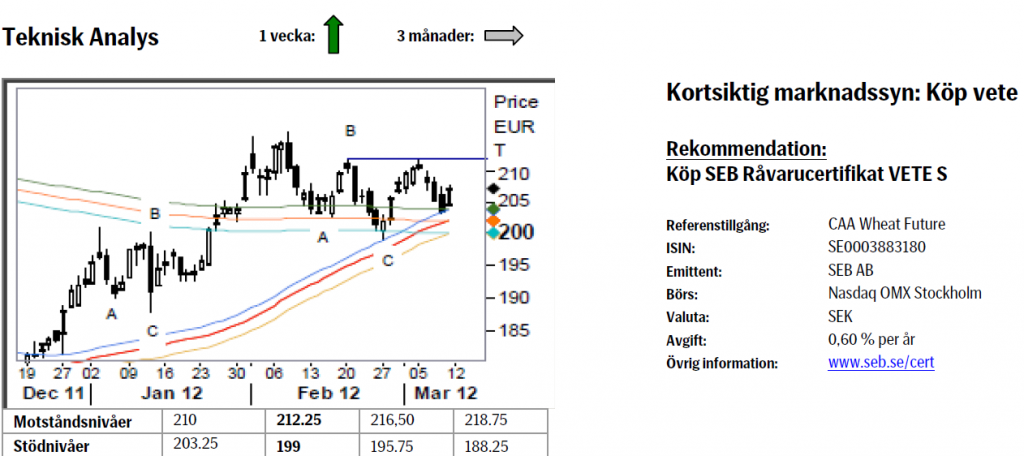Analys
SEB – Råvarukommentarer vecka 11 2012
Sammanfattning: Föregående vecka
 Brett råvaruindex: -0,96 %
Brett råvaruindex: -0,96 %
UBS Bloomberg CMCI TR Index- Energi: +1,05 %
UBS Bloomberg CMCI Energy TR Index - Ädelmetaller: -0,09 %
UBS Bloomberg CMCI Precious Metals TR Index - Industrimetaller: -2,02 %
UBS Bloomberg CMCI Industrial Metals TR Index - Jordbruk: -2,24 %
UBS Bloomberg CMCI Agriculture TR Index
Kortsiktig marknadssyn:
- Guld: Neutral
- Olja: Neutral/sälj
- Koppar: Neutral/sälj
- Majs: Neutral/köp
- Vete: Köp
Guld
- Guldpriset föll efter fredagens arbetsstatistik, vilken var något bättre än förväntat. Den amerikanska sysselsättningen utanför jordbrukssektorn ökade med 227 000 personer, totalt sett åtta procent över förväntan. Arbetslösheten låg kvar på 8,3 procent. Totalt var 12,8 miljoner människor arbetslösa i februari.
- Dollarn sjönk på beskedet och eventuellt kan siffrorna leda till att marknaden förväntar sig att FED kommer att höja räntan snabbare än den tidigare utannonserad räntebanan vill göra gällande.
- Guldet reagerade även negativt på att Kina, som av många ses som den globala ekonomins motor, sänkte sitt tillväxtmål för 2012. Detta skulle kunna indikera en minskning i landets stimulansåtgärder, något som i praktiken talar mot ett högre guldpris.
- Enligt National Bureau of Statistics har även den kinesiska guldproduktionen ökat kraftigt, men det ökade utbudet kommer till stor del att fångas upp av en stark inhemsk efterfrågan.
- ECB lämnade räntan oförändrad. Detta var helt i linje med marknadens förväntningar och innebär en fortsatt låg alternativkostnad till att hålla guld.
- Många taktiska investerare minskar nu sina innehav i guld, detta delvis som en funktion av den starka dollarn. Vi förhåller oss fortsatt neutrala till guldpriset.
- Teknisk Analys: I och med att vi hållit oss under 1740 befinner vi oss fortfarande i korrektionsfasen. Ett först försök ned i 55/233d medelvärdesbanden har avvisats något som mycket väl kan vara slutet på korrektionen och en uppgång över 1725/40 bekräftar att så är fallet. Fram till dess kvarstår dock en viss osäkerhet.
Kortsiktig marknadssyn: Neutral
Olja
- Hoppet om minskade spänningar i Mellanöstern har ökat i och med beskedet att USA, Ryssland, Kina, Storbritannien, Frankrike och Tyskland ska träffa Irans chefsförhandlare. Samtalen kommer då att röra kärnenergiprogrammet och osäkerheten är stor inför dessa möten. President Barack Obama har i sin tur sagt att det fortfarande finns utrymme för en diplomatisk lösning.
- Även de bilaterala spänningarna mellan Israel och Iran består. Israels premiärminister Netanyahu sade efter ett möte med president Obama att han inte kommer tillåta att Israel blir hotat av ett iranskt kärnvapen. I Iran svarade en ledamot i försvarsutskottet att Irans militära kapacitet har växt och att landet skulle hämnas en eventuell attack från israeliskt håll.
- Ovan nämnda situation fortsätter att prägla oljemarknaden. Skulle man mot all förmodan nå en överenskommelse skulle det minska spänningarna avsevärt.
- Den ökade andelen spekulativa köpare av olja skulle kunna förstärka rörelsen rejält vid en eventuell nedgång. Detta då ett unisont säljande skulle aktivera en mängd stoploss-nivåer.
- Vi förhåller oss svagt negativa till oljepriset denna vecka.
- Teknisk Analys: Förra veckas misslyckade försök att ta sig upp ur den stigande parallell-kanalen har vare sig lockat till något aggressivare säljande (vilket man kanske kunde ha väntat sig) eller något förnyat köpande av betydelse. Därav att vi går in i nästa vecka med en neutral vy dock med en viss faiblesse för ytterligare nedgång. Ett brott under 121 skulle utlösa en huvud skuldra topp formation och en nedgång till antingen 119 eller 116.
Kortsiktig marknadssyn: Neutral/sälj olja
Koppar
- Enligt en rådgivare till den Kinesiska centralbanken kommer fastighetspriserna att fortsätta sjunka under året, men detta innebär inte att vi får se ett stort prisfall. Regeringen kommer att fortsätta strama åt fastighetsmarknaden, men målet med åtstramningarna är en kontrollerad prisutveckling.
- Lagernivån hos London Metal Exchange är för närvarande 289 000 ton, vilken är den lägsta nivån sedan augusti 2009. Samtidigt uppvisar Shanghai både höga lagernivåer och en god kopparproduktion.
- Kinesisk statistik visar att inflationen för februari var 3,2 % vilket är 20-månaderslägsta. Detta innebär att den nu är under målet på 4 procent, något som väcker förhoppningar om kommande monetär stimulans. Enligt Kinas premiärminister förväntas Kina uppvisa en tillväxt på 7,5 procent, vilket är mindre än den åttaprocentiga tillväxt som landet alltid haft som målsättning. Enligt premiärministern kommer landet att föra en försiktig monetär politik vilket gör att marknaden kan förvänta sig ytterligare stimulans.
- Enligt CFTC ökar andelen spekulativa positioner och uppmäter nu 155 000 kontrakt, vilket är den högsta nivån sedan augusti 2011. Detta öppnar för en förstärkning av eventuella negativa prisrörelser.
- Teknisk Analys: Vi noterar, med en viss tillfredsställelse, att vi nu fått både en lägre topp samt, vilket är viktigare, en andra bortstötning från 233dagars bandet. Vi tror att detta torde vara nog för att attrahera ett tilltagande säljtryck varför vi håller en försiktig negativ vy inför nästa vecka.
Majs
- I mars månads WASDE-rapport, vilken kom ut i fredags eftermiddag, justerade det amerikanska jordbruksdepartementet (USDA) ned sin prognos något avseende de globala majslagren.
- Marknaden hade dock förväntat sig ännu svagare siffror, detta efter de senaste månadernas köldvåg runt Svarta havet samt torkan i Sydamerika.
- Totalt sett var majspriset ned under förra veckan, men fredagens rapport fick priset att komma upp en del igen innan veckan kunde summeras. Enligt ett marknadsbrev från CME hade en hel del spekulanter positionerat sig mot en nedgång i samband med rapporten, dessa aktörer hjälpte majspriset uppåt då de var tvungna att stänga ut sina positioner.
- Bortsett från den förhållandevis intetsägande rapporten för majs var det stora samtalsämnet den ökade importen från Kina under 2012. Även detta tryckte upp priserna.
- Fundamentalt sett bedömer vi att efterdyningarna efter fredagens rapport kan få priset att ligga kvar, eller till och med gå upp något denna vecka. Vi väljer att särskilt hålla ögonen på den sydamerikanska utvecklingen.
- Teknisk Analys: Försöket att bryta dödläget genom ett brott upp ur innevarande intervall misslyckades då det enda resultatet av testet blev en s.k. spik, dvs. rakt upp och rakt ned samma dag. Misslyckandet muntrade i sin tur upp säljarna som därefter lyckats pressa ned priset till 55dagars medelvärdesbandet, det primära stödet. Veckans utveckling gör att vi bibehåller en neutral vy.
Vete
- Efter att ha fallit under hela veckan kom vetepriset i Paris tillbaka ordentligt under fredagen, detta trots att prognosen på lagernivåerna i Euroland justerades upp något jämfört med förra månadens WASDE-rapport.
- På global basis reviderade USDA ned sin syn på vetelagren. Detta fick enligt ovan priset i Paris, men även i Chicago, att på fredagen återhämta sig något jämfört med föregående dagar.
- En nation vars vetebehov diskuterats flitigt i dagarna är Iran, där importen väntas bli förhållandevis stor under 2012. Faktum är att USDA:s största uppjustering av importbehovet är för Iran.
- Enligt en del analytiker börjar en mängd industriella spannmålskonsumenter nu byta från majs till vete som djurfoder, detta då vetepriset än en gång kommit ned strax under majspriset. Som referens kan nämnas att vetepriset i Chicago de senaste 10 åren i snitt varit drygt 40 procent högre än majspriset.
- Med indikationer om ett förväntat ökat behov av vete bedömer vi fundamentalt att risken för vetepriset i Paris denna vecka ligger på uppsidan. Trots att ryska källor idag har gått ut med uppgifter om goda markförhållanden för den kommande skörden tror vi inte att det kommer att kunna trycka priset nedåt denna vecka.
- Teknisk Analys: Med fortsatt bra stöd i medelvärdesbanden (samt de tidigare pekade på upprepade trevågs nedgångarna (A-B-C = korrektiva rörelser) fortsätter vi att peka på bra potential för ytterligare uppgång. Ett brott över 212.25 bör att vara den utlösande faktorn och ett brott ger vid handen ett mål uppemot 245.
[box]SEB Veckobrev Veckans råvarukommentar är producerat av SEB Merchant Banking och publiceras i samarbete och med tillstånd på Råvarumarknaden.se[/box]
Disclaimer
The information in this document has been compiled by SEB Merchant Banking, a division within Skandinaviska Enskilda Banken AB (publ) (“SEB”).
Opinions contained in this report represent the bank’s present opinion only and are subject to change without notice. All information contained in this report has been compiled in good faith from sources believed to be reliable. However, no representation or warranty, expressed or implied, is made with respect to the completeness or accuracy of its contents and the information is not to be relied upon as authoritative. Anyone considering taking actions based upon the content of this document is urged to base his or her investment decisions upon such investigations as he or she deems necessary. This document is being provided as information only, and no specific actions are being solicited as a result of it; to the extent permitted by law, no liability whatsoever is accepted for any direct or consequential loss arising from use of this document or its contents.
About SEB
SEB is a public company incorporated in Stockholm, Sweden, with limited liability. It is a participant at major Nordic and other European Regulated Markets and Multilateral Trading Facilities (as well as some non-European equivalent markets) for trading in financial instruments, such as markets operated by NASDAQ OMX, NYSE Euronext, London Stock Exchange, Deutsche Börse, Swiss Exchanges, Turquoise and Chi-X. SEB is authorized and regulated by Finansinspektionen in Sweden; it is authorized and subject to limited regulation by the Financial Services Authority for the conduct of designated investment business in the UK, and is subject to the provisions of relevant regulators in all other jurisdictions where SEB conducts operations. SEB Merchant Banking. All rights reserved.
Analys
More weakness and lower price levels ahead, but the world won’t drown in oil in 2026

Some rebound but not much. Brent crude rebounded 1.5% yesterday to $65.47/b. This morning it is inching 0.2% up to $65.6/b. The lowest close last week was on Thursday at $64.11/b.

The curve structure is almost as week as it was before the weekend. The rebound we now have gotten post the message from OPEC+ over the weekend is to a large degree a rebound along the curve rather than much strengthening at the front-end of the curve. That part of the curve structure is almost as weak as it was last Thursday.
We are still on a weakening path. The message from OPEC+ over the weekend was we are still on a weakening path with rising supply from the group. It is just not as rapidly weakening as was feared ahead of the weekend when a quota hike of 500 kb/d/mth for November was discussed.
The Brent curve is on its way to full contango with Brent dipping into the $50ies/b. Thus the ongoing weakening we have had in the crude curve since the start of the year, and especially since early June, will continue until the Brent crude oil forward curve is in full contango along with visibly rising US and OECD oil inventories. The front-month Brent contract will then flip down towards the $60/b-line and below into the $50ies/b.
At what point will OPEC+ turn to cuts? The big question then becomes: When will OPEC+ turn around to make some cuts? At what (price) point will they choose to stabilize the market? Because for sure they will. Higher oil inventories, some more shedding of drilling rigs in US shale and Brent into the 50ies somewhere is probably where the group will step in.
There is nothing we have seen from the group so far which indicates that they will close their eyes, let the world drown in oil and the oil price crash to $40/b or below.
The message from OPEC+ is also about balance and stability. The world won’t drown in oil in 2026. The message from the group as far as we manage to interpret it is twofold: 1) Taking back market share which requires a lower price for non-OPEC+ to back off a bit, and 2) Oil market stability and balance. It is not just about 1. Thus fretting about how we are all going to drown in oil in 2026 is totally off the mark by just focusing on point 1.
When to buy cal 2026? Before Christmas when Brent hits $55/b and before OPEC+ holds its last meeting of the year which is likely to be in early December.
Brent crude oil prices have rebounded a bit along the forward curve. Not much strengthening in the structure of the curve. The front-end backwardation is not much stronger today than on its weakest level so far this year which was on Thursday last week.

The front-end backwardation fell to its weakest level so far this year on Thursday last week. A slight pickup yesterday and today, but still very close to the weakest year to date. More oil from OPEC+ in the coming months and softer demand and rising inventories. We are heading for yet softer levels.

Analys
A sharp weakening at the core of the oil market: The Dubai curve

Down to the lowest since early May. Brent crude has fallen sharply the latest four days. It closed at USD 64.11/b yesterday which is the lowest since early May. It is staging a 1.3% rebound this morning along with gains in both equities and industrial metals with an added touch of support from a softer USD on top.

What stands out the most to us this week is the collapse in the Dubai one to three months time-spread.
Dubai is medium sour crude. OPEC+ is in general medium sour crude production. Asian refineries are predominantly designed to process medium sour crude. So Dubai is the real measure of the balance between OPEC+ holding back or not versus Asian oil demand for consumption and stock building.
A sharp weakening of the front-end of the Dubai curve. The front-end of the Dubai crude curve has been holding out very solidly throughout this summer while the front-end of the Brent and WTI curves have been steadily softening. But the strength in the Dubai curve in our view was carrying the crude oil market in general. A source of strength in the crude oil market. The core of the strength.
The now finally sharp decline of the front-end of the Dubai crude curve is thus a strong shift. Weakness in the Dubai crude marker is weakness in the core of the oil market. The core which has helped to hold the oil market elevated.
Facts supports the weakening. Add in facts of Iraq lifting production from Kurdistan through Turkey. Saudi Arabia lifting production to 10 mb/d in September (normal production level) and lifting exports as well as domestic demand for oil for power for air con is fading along with summer heat. Add also in counter seasonal rise in US crude and product stocks last week. US oil stocks usually decline by 1.3 mb/week this time of year. Last week they instead rose 6.4 mb/week (+7.2 mb if including SPR). Total US commercial oil stocks are now only 2.1 mb below the 2015-19 seasonal average. US oil stocks normally decline from now to Christmas. If they instead continue to rise, then it will be strongly counter seasonal rise and will create a very strong bearish pressure on oil prices.
Will OPEC+ lift its voluntary quotas by zero, 137 kb/d, 500 kb/d or 1.5 mb/d? On Sunday of course OPEC+ will decide on how much to unwind of the remaining 1.5 mb/d of voluntary quotas for November. Will it be 137 kb/d yet again as for October? Will it be 500 kb/d as was talked about earlier this week? Or will it be a full unwind in one go of 1.5 mb/d? We think most likely now it will be at least 500 kb/d and possibly a full unwind. We discussed this in a not earlier this week: ”500 kb/d of voluntary quotas in October. But a full unwind of 1.5 mb/d”
The strength in the front-end of the Dubai curve held out through summer while Brent and WTI curve structures weakened steadily. That core strength helped to keep flat crude oil prices elevated close to the 70-line. Now also the Dubai curve has given in.

Brent crude oil forward curves

Total US commercial stocks now close to normal. Counter seasonal rise last week. Rest of year?

Total US crude and product stocks on a steady trend higher.

Analys
OPEC+ will likely unwind 500 kb/d of voluntary quotas in October. But a full unwind of 1.5 mb/d in one go could be in the cards

Down to mid-60ies as Iraq lifts production while Saudi may be tired of voluntary cut frugality. The Brent December contract dropped 1.6% yesterday to USD 66.03/b. This morning it is down another 0.3% to USD 65.8/b. The drop in the price came on the back of the combined news that Iraq has resumed 190 kb/d of production in Kurdistan with exports through Turkey while OPEC+ delegates send signals that the group will unwind the remaining 1.65 mb/d (less the 137 kb/d in October) of voluntary cuts at a pace of 500 kb/d per month pace.

Signals of accelerated unwind and Iraqi increase may be connected. Russia, Kazakhstan and Iraq were main offenders versus the voluntary quotas they had agreed to follow. Russia had a production ’debt’ (cumulative overproduction versus quota) of close to 90 mb in March this year while Kazakhstan had a ’debt’ of about 60 mb and the same for Iraq. This apparently made Saudi Arabia angry this spring. Why should Saudi Arabia hold back if the other voluntary cutters were just freeriding? Thus the sudden rapid unwinding of voluntary cuts. That is at least one angle of explanations for the accelerated unwinding.
If the offenders with production debts then refrained from lifting production as the voluntary cuts were rapidly unwinded, then they could ’pay back’ their ’debts’ as they would under-produce versus the new and steadily higher quotas.
Forget about Kazakhstan. Its production was just too far above the quotas with no hope that the country would hold back production due to cross-ownership of oil assets by international oil companies. But Russia and Iraq should be able to do it.
Iraqi cumulative overproduction versus quotas could reach 85-90 mb in October. Iraq has however steadily continued to overproduce by 3-5 mb per month. In July its new and gradually higher quota came close to equal with a cumulative overproduction of only 0.6 mb that month. In August again however its production had an overshoot of 100 kb/d or 3.1 mb for the month. Its cumulative production debt had then risen to close to 80 mb. We don’t know for September yet. But looking at October we now know that its production will likely average close to 4.5 mb/d due to the revival of 190 kb/d of production in Kurdistan. Its quota however will only be 4.24 mb/d. Its overproduction in October will thus likely be around 250 kb/d above its quota with its production debt rising another 7-8 mb to a total of close to 90 mb.
Again, why should Saudi Arabia be frugal while Iraq is freeriding. Better to get rid of the voluntary quotas as quickly as possible and then start all over with clean sheets.
Unwinding the remaining 1.513 mb/d in one go in October? If OPEC+ unwinds the remaining 1.513 mb/d of voluntary cuts in one big go in October, then Iraq’s quota will be around 4.4 mb/d for October versus its likely production of close to 4.5 mb/d for the coming month..
OPEC+ should thus unwind the remaining 1.513 mb/d (1.65 – 0.137 mb/d) in one go for October in order for the quota of Iraq to be able to keep track with Iraq’s actual production increase.
October 5 will show how it plays out. But a quota unwind of at least 500 kb/d for Oct seems likely. An overall increase of at least 500 kb/d in the voluntary quota for October looks likely. But it could be the whole 1.513 mb/d in one go. If the increase in the quota is ’only’ 500 kb/d then Iraqi cumulative production will still rise by 5.7 mb to a total of 85 mb in October.
Iraqi production debt versus quotas will likely rise by 5.7 mb in October if OPEC+ only lifts the overall quota by 500 kb/d in October. Here assuming historical production debt did not rise in September. That Iraq lifts its production by 190 kb/d in October to 4.47 mb/d (August level + 190 kb/d) and that OPEC+ unwinds 500 kb/d of the remining quotas in October when they decide on this on 5 October.

-

 Nyheter4 veckor sedan
Nyheter4 veckor sedanMahvie Minerals i en guldtrend
-

 Analys4 veckor sedan
Analys4 veckor sedanVolatile but going nowhere. Brent crude circles USD 66 as market weighs surplus vs risk
-

 Nyheter4 veckor sedan
Nyheter4 veckor sedanAktier i guldbolag laggar priset på guld
-

 Nyheter4 veckor sedan
Nyheter4 veckor sedanKinas elproduktion slog nytt rekord i augusti, vilket även kolkraft gjorde
-

 Nyheter3 veckor sedan
Nyheter3 veckor sedanTyskland har så höga elpriser att företag inte har råd att använda elektricitet
-

 Nyheter4 veckor sedan
Nyheter4 veckor sedanGuld når sin högsta nivå någonsin, nu även justerat för inflation
-

 Nyheter4 veckor sedan
Nyheter4 veckor sedanDet stigande guldpriset en utmaning för smyckesköpare
-

 Analys3 veckor sedan
Analys3 veckor sedanBrent crude ticks higher on tension, but market structure stays soft


